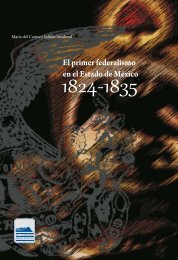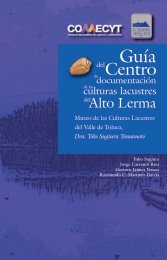You also want an ePaper? Increase the reach of your titles
YUMPU automatically turns print PDFs into web optimized ePapers that Google loves.
KORPUS <strong>21</strong>, VOL. 2, NÚM. 4, 20<strong>21</strong>, 163-178<br />
tas criticized growing diplomatic relations<br />
between the Mexican and United States governments.<br />
Conservative politicians sought<br />
to protect and defend Mexico’s honor, but<br />
did not believe declaring war was necessary<br />
(Jones, 2014: 65-67).<br />
The Roman Catholic Church, on the other<br />
hand, did agree to support the war effort.<br />
It was significant when the archbishop of<br />
Mexico City, Luis María Martínez, affirmed<br />
that “it falls to the Civil Government to define<br />
for a nation the attitude that it ought<br />
to adopt in international affairs and especially<br />
in conflicts with other nations” and that<br />
therefore, “we Catholics ought to put aside<br />
our personal ideas, however well founded<br />
they might seem to us, in order to comply<br />
with the dispositions issued by the Civil Authority”.<br />
Martínez added that “duty and patriotism”<br />
demanded cooperation with the<br />
war effort, calling patriotism “a profoundly<br />
Christian virtue that imposes unity and harmony<br />
in these moments which are so grave<br />
for our Fatherland” (Jones, 2014: 67).<br />
While it was not, as Jones notes, “a ringing<br />
endorsement of Mexico’s entry into the war”,<br />
they did clearly indicate that Mexico’s Catholics<br />
should accept the government’s decision<br />
to enter the war. Jones also notes that<br />
the cleric’s statement might well have come<br />
at the urging of Ávila Camacho: the president<br />
later told Ambassador Messersmith that just<br />
prior to his declaration of a state of war in May,<br />
he had held a meeting with the archbishop in<br />
which he had told the head of the Mexican<br />
church that he found too great apathy on the<br />
part of the clergy and of the Church towards<br />
the war [and that] he felt the Church was not<br />
helping itself by this lack of a clearly defined<br />
attitude (Jones, 2014: 67).<br />
By 1943 government officials had met<br />
with the archbishop to discuss the role of the<br />
Church in the war effort. Martínez agreed,<br />
in a show of unity, to support public statements<br />
indicating that Catholics, like other<br />
Mexicans, were cooperating with government<br />
actions to support the war (Moreno,<br />
2003: 68).<br />
The archbishop largely agreed with Ávila<br />
Camacho both because of his own personal<br />
beliefs but also because he was pleased<br />
with the growing rapprochement between<br />
the Mexican government and the Catholic<br />
Church (Jones, 2014: 85-87). Ávila Camacho<br />
presented himself as a believer, with<br />
conservative values, who made a distinction<br />
between fanaticism and Catholicism, and<br />
therefore did not support religious persecution.<br />
He actively sought cooperation with<br />
the Catholic Church (Blancarte and Veloz<br />
Leija, 2018: 102). The Catholic Church had<br />
also supported the 1938 Oil Expropriation<br />
and had organized fundraising drives to support<br />
the cause —supporting the war effort<br />
was not the first time they had worked with<br />
the postrevolutionary government (Kiddle,<br />
2015: 111; Pérez Flores and Cunha Filho,<br />
2020: 682). Other members of the Catholic<br />
hierarchy seized upon the declaration<br />
of a state of war as a moment to make a<br />
subtle push for the expansion of the role of<br />
the church in public life. For example, one<br />
archbishop took the opportunity to argue<br />
for Catholic priests to play the role of army<br />
chaplains (Jones, 2014: 89). After Mexico<br />
entered the war, Acción Católica Mexicana<br />
began to organize events in support of<br />
the government. Their activities included<br />
organized prayers, material assistance and<br />
promoting patriotism (Rankin, 2010). Historian<br />
Thomas Rath also notes that the 1940s<br />
saw a gradual rapprochement between the<br />
army and the Catholic Church. The church<br />
hierarchy, along with the leaders of Acción<br />
Católica Mexicana supported the war effort<br />
in 1942, and the government allowed priests<br />
into military hospitals (Rath, 2013: 76).<br />
Once Mexico entered the war, the government<br />
implemented a program of compulsory<br />
military service at the end of 1942,<br />
instituting a draft for eighteen-year-old men<br />
(Jones, 2014: 95). The draft was intended to<br />
expand the size of the military to defend<br />
Mexico, as well as to serve as a means to<br />
teach young men valuable skills as well as a<br />
sense of citizenship (Jones, 2014: 114). Rath<br />
notes that many continued to protest conscription,<br />
and many of these protests were<br />
167



![bicentenario_1[V2]](https://img.yumpu.com/68677971/1/167x260/bicentenario-1v2.jpg?quality=85)
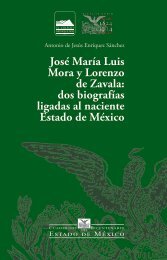
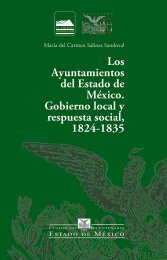

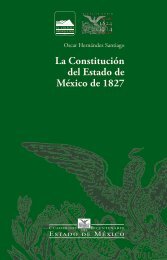
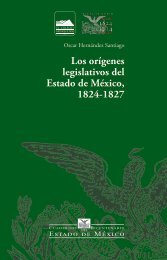
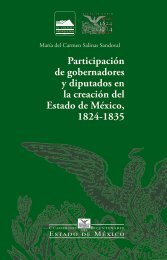
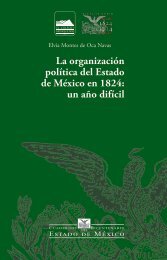
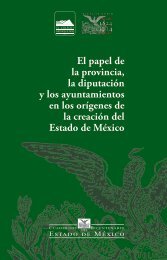

![El_primer_federalismoEM[final]_compressed (2)](https://img.yumpu.com/68483279/1/178x260/el-primer-federalismoemfinal-compressed-2.jpg?quality=85)
